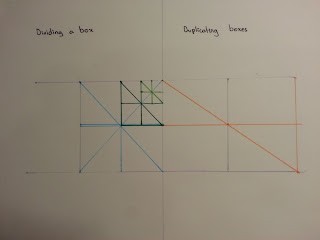For the past few years, I have drawn mostly humans trying to get the face alignment and body proportions right. I haven't thought much in drawing inanimate objects and large scale backgrounds. As I look through the book
How to Draw by Scott Robertson with Thomas Bertling, I can see the many different skills one needs to understand to draw an inanimate object. Perspective is an illusion and drawing it is just an approximation of how we see the world (Robertson, and Bertling 21). Many of the techniques that Robertson includes has given me a new look on how to draw an object in perspective and formally. This style of drawing makes erasing a disadvantage since it may erase intersecting construction lines that may be needed to explain your drawing (Robertson, and Bertling 13).
 |
| Dividing and duplicating boxes in perspective. |
 |
| Dividing and duplicating boxes in two-dimensional space |
One of the first things you learn in the book are the different techniques used to draw in perspective. Some of the techniques include using vanishing points, dividing / multiplying boxes, and duplicating boxes in perspective. According to Robertson and Bertling, "Being able to divide and multiply dimensions in perspective is one of the key building tools used to generate drawings."(30).
Using these techniques to divide and measure distance, I created a simple stair case with no details in 2 point perspective. I first set up 2 points to use as vanishing points on opposite sides of the paper. Then I created a simple Grid by equally spacing out spaces on the main line (highlighted in red) to create equal steps to the stair case. Using the diaganol line (highlighted in green) I created steps and connected the points together. I used blue pen to show the main staircase so it will stand out from the other lines on the paper.
Do you think there is a simpler way to draw a staircase or are these techniques easy to use?
Robertson, Scott, and Thomas Bertling. How to Draw: Drawing and Sketching Objects and Environments from Your Imagination. CA: Design Studio, 2013. Print.



I can relate a lot to this post. For my drawings, I focus primarily on humans or animals, not inanimate objects. However, from my experience in art class we used the same technique to draw staircases. This makes me believe that this technique is one of the best ways to draw staircases that look realistic.
ReplyDeleteIn making my blog, I have learned about this same method. If you are trying to draw accurately I don't think there are any easier methods.
ReplyDelete